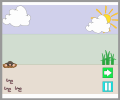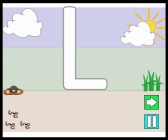How picture and colour clues aid the handwriting process
The advantages of using picture and colour clues
When beginning to form pre-handwriting patterns, letters or numbers it is a good idea to use plain paper, as the aim at this stage is to learn how to form the letters correctly not size or neatness, that comes later.
However when it is time the use of colour and picture clues, to help a child develop an understanding of shape and letter size, position and placement, can be a very powerful tool.
At Teach Handwriting we use three colours to form a natural background scene, which young children can easily identify with, that of the sky (blue), grass/land (green) and soil/earth (brown) with small picture clues to help increase the visual understanding of different areas for placement recognition.

The theory behind this is that children will often depict this kind of outdoor scene in their own drawings and so it is familiar to them. They learn very quickly that the sun is drawn up in the sky, that flowers or trees are drawn on the grass level, usually the middle section of their drawing, and things like roots or worms are drawn in the lower part of the drawing in the dirt. This placement knowledge becomes instinctive which is why placing the letters on this type of background can help to stimulate that same visual memory recall for letter placement.
It can create a sub-conscious memory in a child’s mind of where particular letters sit in relation to others without the constraints of lines or obvious boundaries, especially as the picture can be any size.
Explaining how to use the picture and colour clues
The colour and picture clues can also be used to help talk through how to form the shapes and letters, as you explain to a child how to draw them, as well as when they are having a go themselves, as there are clear markers for a child to identify, for example in explaining how to form a capital L:
- Start at the top of the sky or blue section and draw a line straight down through the sky and grass. Stopping at the bottom of the grass, being careful not to go into the soil/ brown section.
- Keep you pencil on the paper and move it along the bottom of the grass to draw a short line headed towards the tall grass on the right hand side of the page – take your pencil off the paper.
- Well done you have drawn/written the capital letter L (always use the letter names when drawing letters whether it be upper-case (capital) or lower-case letters).
As handwriting skills develop so the visual clues reduce, until they are not required anymore.
When confronted with a large piece of paper young children differ greatly in their response. Some will happily draw big shapes and fill the whole sheet; others will just use the centre of the page, while some will keep it small and in one area of the paper. This tends to naturally change over time; however some children need more encouragement to use other areas of the paper. The colour and picture clues can help to support this development, guiding a child with different start and finish points in various locations on the page.
Some children, especially those with learning difficulties related to Asperger’s and Autism, may find the colours distracting. We would suggest printing the worksheets using the ‘print in grey scale’ option (black and white) so that the handwriting areas are varying shades of grey, giving distinct areas to help support and develop their understanding of position and placement.



